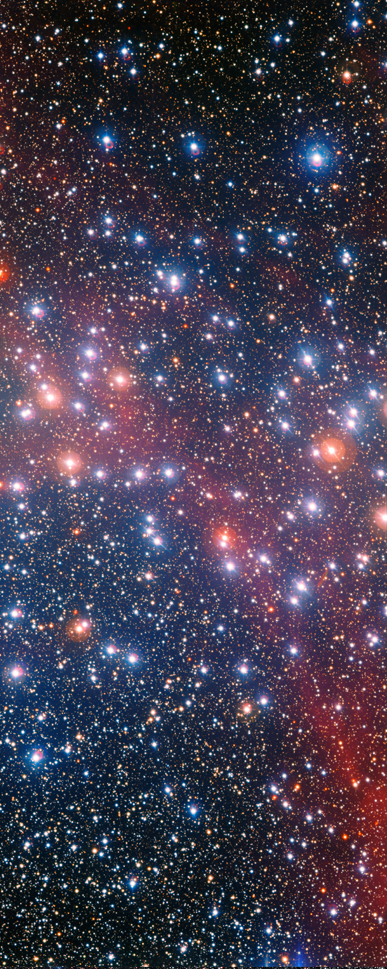NGC 3532
Un Ammasso variopinto
Il telescopio MPG / ESO da 2,2 metri a La Silla dell'ESO in Cile ha catturato questa visione riccamente colorata del luminoso ammasso stellare NGC 3532. Alcune delle stelle ancora brillano con un colore bluastro, che indicano stelle più giovani e calde. Ma molte di queste stelle sono diventate più massicce, giganti rosse, con un bagliore di una ricca tonalità arancione. Sono stelle più vecchie e fredde.
The colourful star cluster NGC 3532
The MPG/ESO 2.2-metre telescope at ESO’s La Silla Observatory in Chile captured this richly colourful view of the bright star cluster NGC 3532. Some of the stars still shine with a bluish colour, youngest and hot stars. But many of the more massive ones have become red giants and glow with a rich orange hue. They're old and cold stars.
Crediti: ESO/G. Beccari, eso1439a
NGC 3532 ammasso aperto
NGC 3532 è un ammasso aperto brillante, a circa 1300 anni luce da noi, nella costellazione della Carena. È noto in modo informale come l'ammasso del "Pozzo dei Desideri", poichè ricorda una manciata di monete d'argento lanciate in un pozzo. Viene anche chiamato l'ammasso del "Football" (cioè del Pallone), ma il nome è appropriato solo per chi vive da un lato dell'Atlantico. Ha infatti guadagnato questo epiteto a causa della sua forma ovale, che può sembrare, per chi è familiare con il gioco, un pallone da rugby. Per sapere di più...
NGC 3532 is a bright open cluster located some 1300 light-years away in the constellation of Carina (The Keel of the ship Argo). It is informally known as the Wishing Well Cluster, as it resembles scattered silver coins which have been dropped into a well. It is also referred to as the Football Cluster, although how appropriate this is depends on which side of the Atlantic you live. It acquired the name because of its oval shape, which citizens of rugby-playing nations might see as resembling a rugby ball. More info...
Il colore delle stelle
La temperatura superficiale di una stella di sequenza principale è determinata dalla quantità di energia che viene prodotta nel nucleo e dal raggio del corpo celeste. Un valido strumento per la sua misurazione è l'indice di colore, che è normalmente associato alla temperatura effettiva, vale a dire la temperatura di un corpo nero ideale che irradia la propria energia con una luminosità per area superficiale simile a quella della stella presa in considerazione. Le stelle hanno temperature superficiali variabili fra i 2.000 e i 50.000 K. Le classi spettrali di Harvard sono solitamente elencate dalla più calda alla meno calda con le lettere dell'alfabeto. Per saperne di più...
The surface temperature of a main sequence star is determined by the rate of energy production of its core and by its radius, and is often estimated from the star's color index. The temperature is normally given in terms of an effective temperature, which is the temperature of an idealized black body that radiates its energy at the same luminosity per surface area as the star. Main-sequence stars vary in surface temperature from approximately 2,000 to 50,000 K. The Harvard classification system is a one-dimensional classification scheme using single letters of the alphabet, optionally with numeric subdivisions, to group stars according to their spectral characteristics. More info...
Diagramma HR: Il diagramma Hertzsprung-Russell (dal nome dei due astronomi,dal tedesco Ejnar Hertzsprung e lo statunitense Henry Norris Russell, che intorno il 1910 lo idearono indipendentemente) è una tabella teorica che mette in relazione la temperatura superficiale (riportata in ascissa) e la luminosità (riportata in ordinata) delle stelle. Image Credit: NASA, Chandra
HR diagram: The Hertzsprung–Russell diagram, is a scatter graph of stars showing the relationship between the stars' absolute magnitudes or luminosities versus their stellar classifications or effective temperatures. More simply, it plots each star on a graph measuring the star's brightness against its temperature (color). Image Credit: NASA, Chandra
Sistema Solare Interno Mercurio Venere Terra | Sistema Solare Esterno | Via Lattea | Universo Supernova Extragalattiche |
Prenota la mostra per i tuoi eventi (da novembre 2017) | |||






































